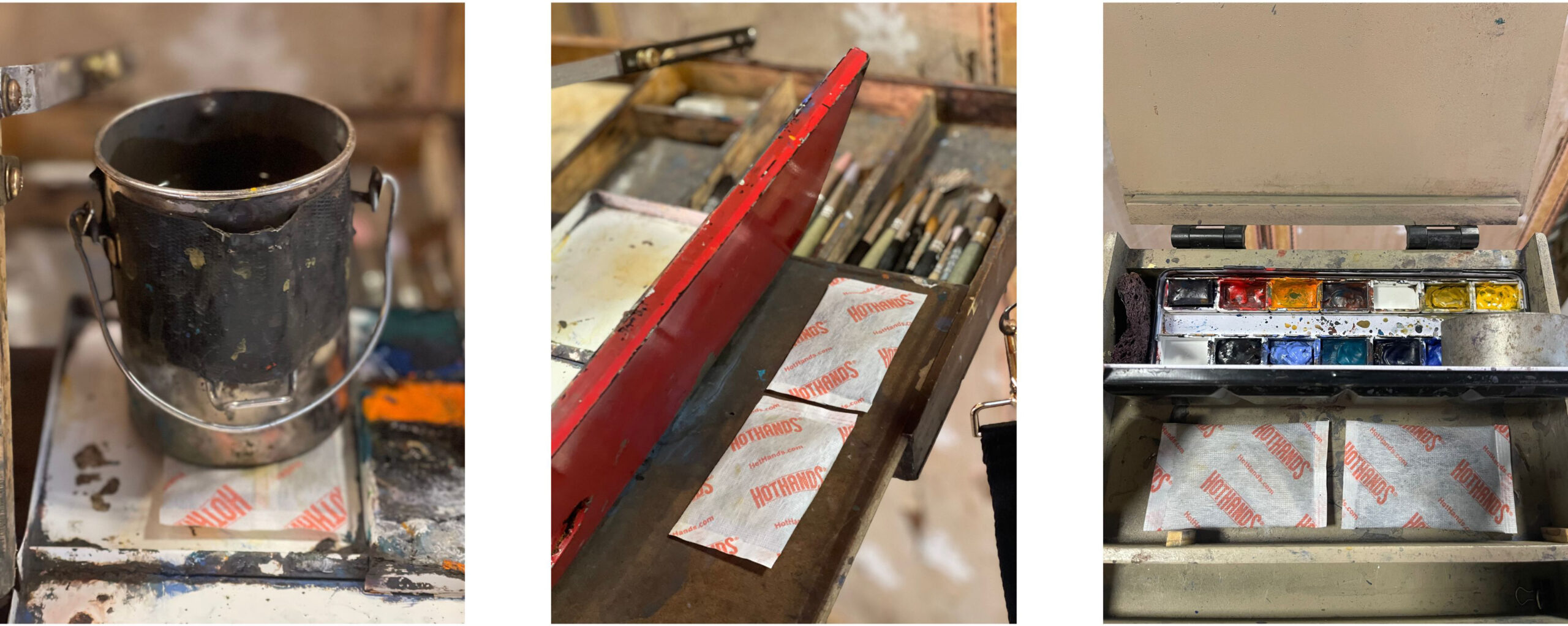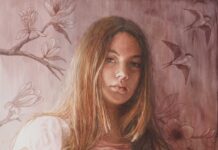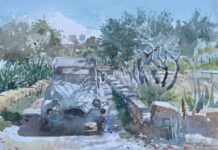
Plein Air Watercolor — Can you paint with watercolor in freezing temps? Dan Marshall shares his tips on painting snow and how to manage watercolor in winter conditions.
Tips to Avoid Painting in Slushy Color
By Dan Marshall
We all know plein air painting in watercolor can be challenging enough, why oh why would we want to do it in cold, wintry weather!?!
Well, to truly see and learn the colors of snow and snowy effects, there’s nothing more beneficial than actually seeing it. Staring at snow for the duration of a painting, you will start to see things that can never be seen in a photograph. You’ll experience true seeing, hearing, feeling, smelling, and touching in real life. The big secret benefit of plein air painting is the involvement of all of our senses, informing our paintings on a much deeper level than “oh, that sure looks pretty” and elevating them to fine art.
Setting yourself up for cold weather success in watercolor has nothing to do with, and even though it may sound really cool to say this, “putting vodka in your water.” This falls into the old watercolor stereotype of “Did you make that texture with salt?” The answer to both of these is a fatigued, “No, I did not.”
As always, there is so much more to consider when working with the complexities of watercolor.
Set yourself up for success.
First of all, I’m going to skip the “dress in warm layers, wear a hat, yada, yada” for this article.
Now, I have experimented mixing with vodka water and it doesn’t really do what you think it would do. “But Vodka doesn’t freeze.” Yes, but you’re not painting with pure vodka. The real problem is when you have a metal palette and very thin washes, it will freeze and turn to slush. And even if the temp is slightly above freezing, the wind will be a factor.
In my early plein air painting days, (at the urging of Joseph Zbukvic, emphatically telling me I have to get outside and paint), I would paint with that mixture in the wet, cold, wind tunnel-freezing air of New York City. After completing a painting I’d go to the closest café to warm up. Then I would literally watch my painting melt and smear down the paper as it unthawed and dried. It was like watching in horror a perfectly prepared soufflé go flat.
First, I was painting too wet for the moisture in the air, and second, I thought the vodka in the water would actually work in that level of cold.
Ok, so if not vodka, what’s the solution?
My latest discovery is using hand-warming packs. Keep the vodka to warm your belly! (But personally, I prefer a flask of scotch.)
I use a metal water cup and palette so placing a couple of hand warmers under the palette and one under the cup is just enough to add a little heat and keep the dreaded slush away. This does the trick for temps above freezing, if it’s below freezing, well, it’s WATERcolor. Sometimes we just need to realize and accept the properties of the medium.

Adjust Your Watercolor Technique
Don’t fool yourself into thinking you’ll be able to achieve results painting in the same way you would on a perfect weather day. Painting in cold weather requires an adjustment of your skill set and this will come with careful observation and experience. One thing is certain – it’s important not to work too “wet.”
Keep your washes just a little bit thicker and be extremely careful to not use an overly loaded brush – just enough in the brush to cover the area you want to paint. I will mix enough, but move quickly back and forth from painting to palette, only picking up a small amount of wash at a time.
Boots and Gloves
The thing that affects me the most while painting is cold hands and feet. Even though I wasn’t going to address clothing, it is important to have both boots and gloves. I use a combination of regular and fingerless gloves. Generally, I’ll only wear the fingerless gloves on my painting hand, but if it gets too chilly, I’ll throw on the regular glove to warm it up. Also, investing in a quality pair of cold-weather boots makes a big difference.
The Wind
I’m usually a stickler for standing up while painting, but when the cold wind is blowing, I’ll often take a seat. I use a small, lightweight stool to lower my profile and get closer to the ground. It’s a small adjustment but seems to help my core from getting too cold.
Top Winter Plein Air Painting Tips:
1. Limit your winter watercolor painting days to temps above freezing.
2. Skip the vodka and include small hand warmers in your plein air kit.
3. Keep your work at a smaller, more manageable size depending on the temperature.
4. Be careful not to work too wet.
5. Keep brush loads minimal.

Winter Plein Air Painting Gear
As alluded above, keep your gear to the minimum and make it easier to manage and carry in the snow. I have two different plein air painting setups: a larger one for warmer winter days and a smaller for colder weather excursions. Both contain my palette, brushes, etc., so I don’t have equipment all over the place. In cold conditions, I also don’t want to have to deal with masking tape so I tend to paint on watercolor blocks.
On slightly warmer winter days I may still limit myself to a quarter sheet (11 x 15-in.). On colder days I work smaller, 8 x 10 or 9 x 12 maximum.

My Basic Winter Plein Air Painting Kit
1. Larger Pochade Box containing palette, paper, brushes, water cup
2. Waterproof boots
3. Hand warmers (for palette and water cup)
4. Lightweight tripod
5. Lightweight compact stool
6. Gloves: regular and fingerless
7. Flask (scotch)
8. Thermos (coffee)
9. Smaller Pochade Box
For Dan Marshall’s full equipment breakdown, palette colors, etc – visit danmarshallart.com. And check out his instructional video, Plein Air Watercolor: Capturing Nature, in which he shows you how to take a complex scene and boil it down to the essentials.







